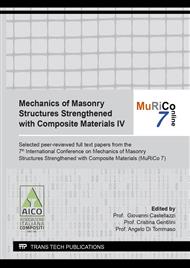[1]
L.G. Baltazar, F.M.A. Henriques, R. Douglas, M.T. Cidade, Experimental characterization of injection grouts incorporating hydrophobic silica fume J. Mater. Civ. Eng. 29 (2017) 04017167.
DOI: 10.1061/(asce)mt.1943-5533.0002021
Google Scholar
[2]
L.G. Baltazar, F.M.A. Henriques, M.T. Cidade, Rheology of natural hydraulic lime grouts for conservation of stone masonry-influence of compositional and processing parameters, Fluids 4(1) (2019) 13.
DOI: 10.3390/fluids4010013
Google Scholar
[3]
A. Zanichelli, A. Carpinteri, G. Fortese, C. Ronchei, D. Scorza, S. Vantadori, S. Contribution of date-palm fibres reinforcement to mortar fracture toughness. Procedia Structural Integrity, 13 (2018), 542-547.
DOI: 10.1016/j.prostr.2018.12.089
Google Scholar
[4]
E. Campello, M.V. Pereira, F. Darwish, The effect of short metallic and polymeric fiber on the fracture behavior of cement mortar. Procedia Mater. Sci. 3 (2014), 1914–(1921).
DOI: 10.1016/j.mspro.2014.06.309
Google Scholar
[5]
A.M. Barrios, D.F. Vega, P.S. Martínez, E. Atanes-Sánchez, C.M. Fernández, Study of the properties of lime and cement mortars made from recycled ceramic aggregate and reinforced with fibers. Journal of Building Engineering, 35, (2021), 102097.
DOI: 10.1016/j.jobe.2020.102097
Google Scholar
[6]
F. Lucolano, B. Liguori, C. Colella, Fibre-reinforced lime-based mortars: A possible resource for ancient masonry restoration. Constr. Build. Mater. 38 (2013), 785–789.
DOI: 10.1016/j.conbuildmat.2012.09.050
Google Scholar
[7]
G. Di Bella, V. Fiore, G. Galtieri, C. Borsellino, A. Valenza, Effect of natural fibers reinforcement in lime plasters (kenaf and sisal vs. polypropylene). Constr. Build. Mater. 58 (2014), 159–165.
DOI: 10.1016/j.conbuildmat.2014.02.026
Google Scholar
[8]
L.G. Baltazar, F.M.A. Henriques, M.T. Cidade, Effects of polypropylene fibers and measurement methods on the yield stress of grouts for the consolidation of heritage masonry walls, Fluids 5(2) (2020) 53.
DOI: 10.3390/fluids5020053
Google Scholar
[9]
EN 459-1 Building Lime-Part 1: Definitions, Specifications and Conformity Criteria; CEN, European Committee for Standardization: Brussels, Belgium (2010).
Google Scholar
[10]
ASTM C494. Standard Specification for Chemical Admixtures for Concrete; ASTM International: West Conshohocken, PA, USA (2005).
Google Scholar
[11]
L.G. Baltazar, F.M.A. Henriques, M.T. Cidade, Rheological characterization of injection grouts using rotational rheometry. In Advances in Rheology Research; Nova Science Publishers, New York, USA, 2017, pp.13-42.
Google Scholar
[12]
L.G. Baltazar, F.M.A. Henriques, M.T. Cidade. Grouts with improved durability for masonry consolidation: An experimental study with non-standard specimens, Key Eng. Mater. 747, (2017) 480-487.
DOI: 10.4028/www.scientific.net/kem.747.480
Google Scholar
[13]
EN 1936:2006. Natural stone test methods – determination of real density and apparent density, and of total and open porosity (2006).
DOI: 10.3403/01663707
Google Scholar
[14]
EN 1015-11:1999. Methods of test for mortars for masonry - Part 11: Determination of flexural and compressive strength of hardened mortar. CEN, European Committee for Standardization (1999).
DOI: 10.3403/01905442u
Google Scholar
[15]
EN 1015-18:2002. Methods of test for mortar for masonry - Part 18: Determination of water absorption coefficient due to capillary action of hardened rendering mortar. CEN, European Committee for Standardization (2002).
DOI: 10.3403/02720093
Google Scholar
[16]
RILEM. Recommended tests to measure the deterioration of stone and to assess the effectiveness of treatment methods. Test no. II.5 – Evaporation Curve. Mater Struct; 75 (1980), 175–253.
Google Scholar
[17]
V.S. Semenov, V.A. Perfilov, D.V. Oreshkin, Environmentally Safe Mortar and Grouting Solutions with Hollow Glass Microspheres. Procedia Engineering, 150, (2016) 1479-1484.
DOI: 10.1016/j.proeng.2016.07.086
Google Scholar
[18]
A. Camões, R. Eires, C. Cardoso, C. Natural fibre reinforced earth and lime based mortars. contribution of sustainable building to meet EU 20-20-20 targets. Universidade do Minho. ISBN: 978-989-96543-7-2, (2013).
Google Scholar
[19]
A. Al-Ghaban, H.A. Jaber, Investigation of addition different fibers on the Performance of cement mortar - Engineering and Technology Journal. 36, (2018) 957-965.
DOI: 10.30684/etj.36.9a.3
Google Scholar


